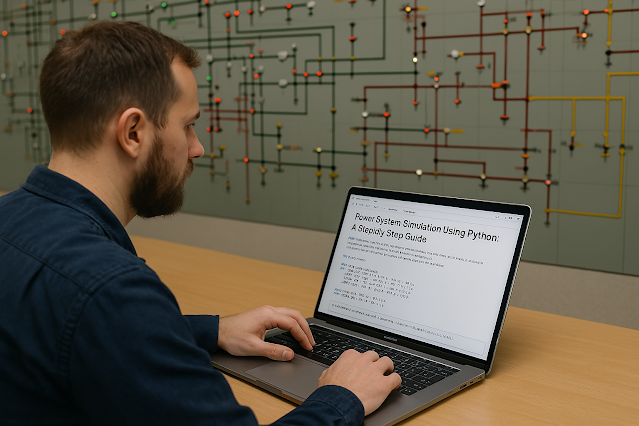The ability to simulate and analyze power systems is critical in modern electrical engineering. From grid expansion planning to load flow and fault analysis, simulation allows engineers to optimize design, ensure stability, and prepare for contingencies. Traditionally, such simulations were done using proprietary software like ETAP, PSS®E, and DIgSILENT PowerFactory. However, the rise of Python in scientific computing has opened the doors to powerful, open-source tools for power system analysis.
This guide provides a step-by-step walk-through on modeling, simulating, and analyzing power systems using Python—with a focus on technical accuracy, extensibility, and practical applications.
1. Overview of Power System Simulation
Why Simulate Power Systems?
Power systems are dynamic and complex. Simulation helps in:
-
Understanding the steady-state behavior (load flow)
-
Analyzing faults and contingency scenarios
-
Performing stability studies
-
Evaluating economic dispatch and optimal power flow
-
Planning grid expansion and renewable integration
Python-based tools offer the ability to customize simulations, automate workflows, and integrate with machine learning pipelines.
2. Mathematical Foundation: Power Flow Equations
Power flow (load flow) analysis solves for voltage magnitude and angle at each bus, given power injections and line parameters. The non-linear power flow equations are:
Where:
-
: real and reactive power injections at bus i
-
: voltage magnitude and angle at bus i
-
: real and imaginary parts of the admittance matrix
Numerical methods like Newton-Raphson and Gauss-Seidel are used to solve these equations.
3. Python Libraries for Power System Simulation
| Library | Purpose |
|---|---|
NumPy |
Efficient array/matrix operations |
SciPy |
Non-linear solvers and sparse matrix support |
Matplotlib / Plotly |
Visualizations |
Pandas |
Tabular data management |
PyPSA |
Open-source library for power flow, OPF, and planning |
Pandapower |
For grid modeling with switchgear and fault analysis |
NetworkX |
For custom graph-based power networks |
In this guide, we’ll use PyPSA for steady-state power flow and OPF simulations.
4. Modeling a Power System in PyPSA
Step 1: Install Required Libraries
pip install pypsa numpy pandas matplotlib
Step 2: Create a Network
import pypsa
net = pypsa.Network()
net.set_snapshots(range(1)) # single time snapshot
Step 3: Add Buses
net.add("Bus", "Bus 1", v_nom=110)
net.add("Bus", "Bus 2", v_nom=110)
net.add("Bus", "Bus 3", v_nom=110)
Step 4: Add Transmission Lines
Transmission lines are added with series impedance , and shunt susceptance .
net.add("Line", "1-2", bus0="Bus 1", bus1="Bus 2", r=0.01, x=0.1, b=0.001, s_nom=100)
net.add("Line", "2-3", bus0="Bus 2", bus1="Bus 3", r=0.01, x=0.1, b=0.001, s_nom=100)
Step 5: Add Generators
net.add("Generator", "Gen 1", bus="Bus 1", p_set=80, control="PQ", marginal_cost=20)
Step 6: Add Loads
net.add("Load", "Load 3", bus="Bus 3", p_set=60, q_set=25)
5. Running a Load Flow Simulation
PyPSA uses linear (DC) or non-linear (AC) power flow solvers. Here’s how to run an AC power flow:
net.pf() # AC power flow using Newton-Raphson
After running the power flow, we can inspect bus voltages, line loading, and power flows.
print(net.buses_t.v_mag_pu)
print(net.lines_t.p0) # Real power flow at sending end
6. Example: Voltage and Power Flow Visualization
import matplotlib.pyplot as plt
voltages = net.buses_t.v_mag_pu.iloc[0]
voltages.plot(kind='bar', title='Bus Voltage Magnitudes (p.u.)', color='skyblue')
plt.ylabel("Voltage (p.u.)")
plt.grid(True)
plt.show()
Similarly, line flows can be plotted to understand loading conditions.
7. Time-Series Load Flow (e.g., Solar Profile)
You can simulate 24-hour variation in load and generation:
import numpy as np
import pandas as pd
snapshots = pd.date_range("2025-01-01", periods=24, freq="H")
net.set_snapshots(snapshots)
# Solar generation profile (sinusoidal)
gen_profile = 50 + 30*np.maximum(0, np.sin(np.linspace(0, 2*np.pi, 24)))
# Load profile (static for now)
load_profile = [60]*24
net.generators_t.p_set["Gen 1"] = gen_profile
net.loads_t.p_set["Load 3"] = load_profile
net.pf() # Solve for all time steps
You can now analyze how grid voltages or flows change over the day.
8. Optimal Power Flow (OPF)
PyPSA can solve DC OPF problems using linear programming to minimize generation cost while satisfying load and line constraints.
net.generators.loc["Gen 1", "marginal_cost"] = 30
net.generators.loc["Gen 1", "p_nom"] = 100
net.loads.loc["Load 3", "p_set"] = 60
net.lopf()
print(net.objective) # Total cost
To make it more interesting, add another generator:
net.add("Generator", "Gen 2", bus="Bus 2", p_nom=100, marginal_cost=10)
net.lopf()
PyPSA will now dispatch the cheaper generator (Gen 2) more.
9. Exporting Simulation Data
net.buses_t.v_mag_pu.to_csv("bus_voltages.csv")
net.lines_t.p0.to_csv("line_flows.csv")
This is helpful for generating reports or integrating with dashboards.
10. Advanced Simulation Ideas
-
Fault Analysis: Use
pandapowerfor short-circuit calculations using IEC 60909 standard. -
Contingency Simulation: Remove a line and check how system behaves.
-
Grid Expansion Planning: Add candidate lines and use
lopfwith cost constraints. -
Renewable Energy Modeling: Load time-series solar/wind profiles from CSV.
FAQs
Q1: How scalable is PyPSA for large networks?
PyPSA supports sparse matrix solvers and can simulate national-scale networks with thousands of buses efficiently. It has been used in modeling European transmission networks.
Q2: How does PyPSA compare to commercial tools like PSS®E?
While PSS®E supports advanced dynamic and protection simulations, PyPSA excels at planning, OPF, and flexibility. It also allows full transparency and integration with other Python tools (e.g., ML, databases).
Q3: Can I simulate battery storage or EV charging?
Yes. PyPSA supports storage units with constraints like state-of-charge, efficiency, and charging/discharging limits.
net.add("StorageUnit", "Battery 1", bus="Bus 2", p_nom=20, max_hours=2, efficiency_store=0.9)
Q4: Is Python fast enough for real-time control?
For offline simulation, Python is excellent. For real-time control, use Python for prototyping and convert performance-critical parts to C/C++ or use JIT compilers like Numba.
Q5: Where can I find standard test systems?
IEEE 9, 14, 30-bus systems are available in open repositories and can be modeled in PyPSA or Pandapower.
Conclusion
Python, with its mature ecosystem and open-source libraries like PyPSA and Pandapower, offers a powerful alternative for power system simulation. It enables deep customization, integration with modern technologies (like machine learning), and supports academic and industrial use cases.
Whether you're a student, researcher, or power systems engineer, Python can empower your workflow with flexible, reproducible, and scalable simulations.

